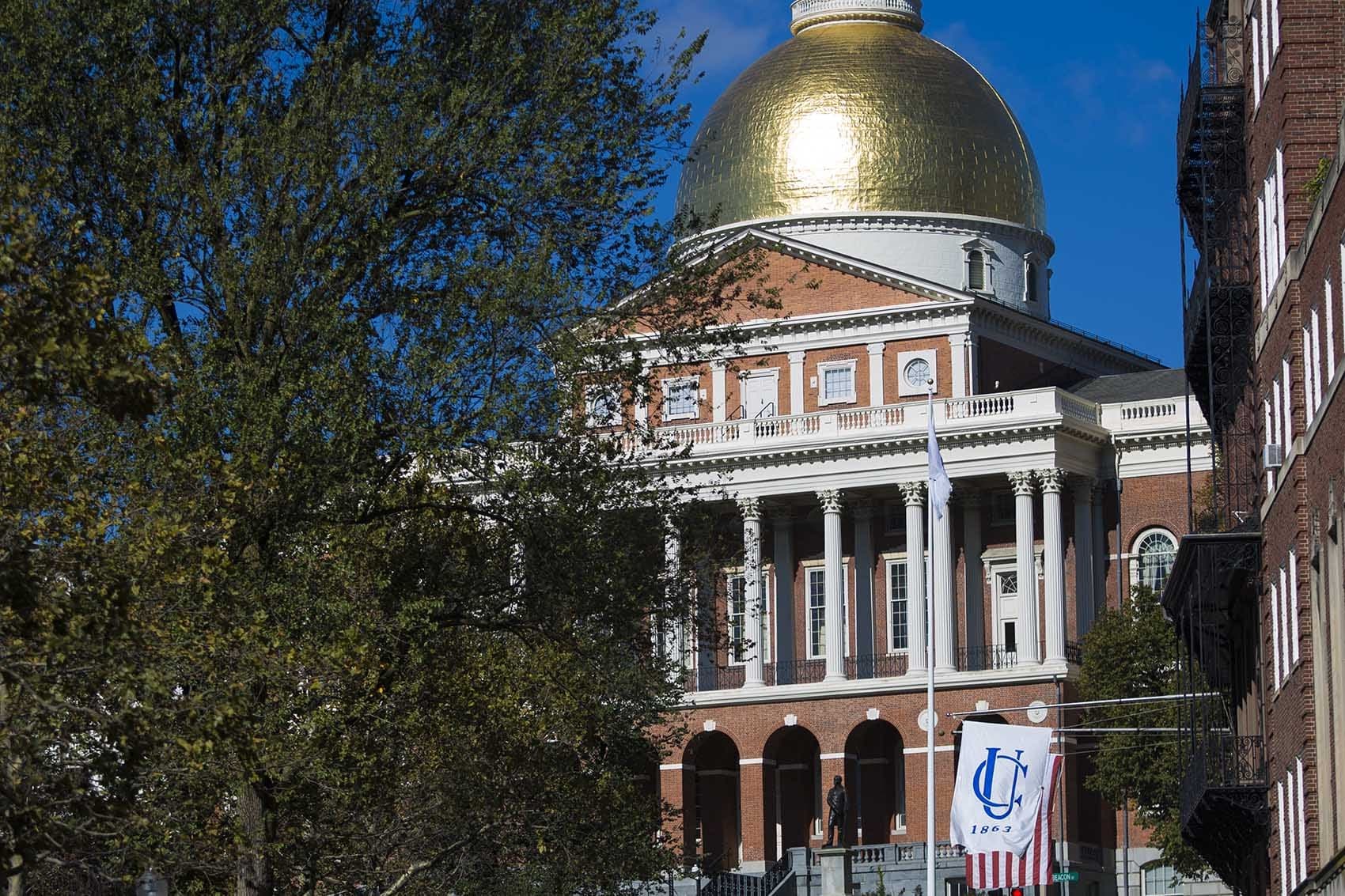
Child care is in crisis. Here's what's being done about it
There’s more than one way to tally the cost of child care.
The sticker price for families is certainly high: Tuition in Massachusetts is the highest among the 50 states. But the system takes other tolls.
Most child care providers run their businesses on razor-thin margins and can only afford to pay their staff around the state's minimum wage. And there are broader impacts: parents stay out of the workforce, businesses are short-staffed and children miss out on educational opportunities.
While these struggles are not new, the pandemic has made them harder to ignore. As staff quit and centers closed, a struggling system was pushed closer to a breaking point. And more business leaders and politicians began to see child care not as a private burden for families and caregivers, but as an urgent public problem.

Here's a closer look at how early childhood education got to this moment, and how stakeholders hope to move forward:
How did we end up here?
For decades, the American child care system has made do with more limited and targeted government support, when compared to other similar countries. That means most families seek out arrangements in what can be a dizzying private marketplace: turning to relatives, neighbors or center-based options.
The last time federal policymakers considered overhauling that system was in 1971. Then-President Richard Nixon was given a bill that would have established universal preschool for 3- and 4-year-olds. He vetoed it.
Nixon’s press secretary Ron Ziegler said the president was "rejecting a congressional proposal that promises far more than we could deliver," citing both the cost and logistics of government-provided care.
But Nixon himself said there were other concerns driving his veto. He called the idea of universal child care “radical … truly a long leap into the dark,” because it appeared likely to drive more parents — especially mothers — out of the home and into the workforce.

Fifty years later, American families have taken the leap anyway, said Latoya Gayle senior director of advocacy of Neighborhood Villages, an early education and child care nonprofit. A 2019 industry report found that roughly three-quarters of Massachusetts children under 5 are in child care for at least part of each week.
“Women go to work and fathers go to work. And so who's taking care of that child?” Gayle asked.
Just like many corners of the economy, the pandemic brought the simmering shortcomings of the child care industry into sharp focus. For one, the essential nature of child care services became impossible to ignore when most providers shut their doors for months during the early days of the pandemic.
Everyone had a child care problem at the same time.
"For the first time ever, I think lots of other actors in the system were entirely affected by people's lack of child care, and that was an unprecedented national scenario," explained Nonie Lesaux, chair of the Massachusetts Board of Early Education and Care.
Advertisement
Even before the pandemic, a 2019 report by the Bipartisan Policy Project found that the state had around 103,000 fewer child care seats than were wanted — a supply gap of almost 33%.
Widespread staff departures that came after 2020 exacerbated the situation. At its worst, the state's child care workforce had shrunk by about 19% as of early 2021. While the workforce has rebounded in the last year, it is still down by 12%, according to the University of California Berkeley's Center for the Study of Child Care Employment.

Over two years into the pandemic, the state is still missing about 8,000 seats that it had pre-pandemic. “That's a dynamic that we have to keep in mind as we go about this ... we can't take three years to figure out the policy," said Colin Jones, a senior policy analyst at the Mass. Budget & Policy Center.
Can the federal government help fix this?
When it comes to federal (and state) policy, it can often take three years to get big legislative proposals through — if they make it to the finish line at all.
So, it can be frustratingly unclear whether and when more federal support for child care might arrive.
President Biden’s social spending bill, dubbed "Build Back Better," included a plan to guarantee affordable child care to families in participating states. The bill would have increased federal subsidies for child care, and gradually expanded the benefit to reach more middle-income families.
But that bill is on ice after resistance from Sen. Joe Manchin (D-W.Va.) over its high price tag. Manchin's office says fighting inflation and paying down national debt are bigger priorities.
Meanwhile, a group of senators are workshopping a more targeted — and less generous — version of that legislation.
What's being done in Massachusetts?
However, early childhood advocates in Massachusetts notice an unprecedented level of movement on Beacon Hill. In March, a special legislative commission on the costs of early education and care released a report that called on the state to "invest in both quality and access" for early childhood care. The report recommended spending approximately $1.5 billion a year.
It seemed like a green light to the Common Start Coalition, a group of lawmakers, advocates and other stakeholders that had drafted a bill in 2021 aiming to make just those kinds of investments. The Common Start bill included several big proposals like a 7% cap on family spending for child care and an expansion of who is eligible for state subsidies up well into the middle class.
That bill also stalled.
But then, in mid-May, the Joint Committee on Education introduced a pared-down version. It lost the 7% spending cap and would expand subsidies more narrowly. Advocates say that bill may make it across the finish line before legislators leave for summer break in July.
Amy O’Leary, the executive director of the nonprofit advocacy group Early Education for All, explained that it's rare to get such quick action on a set of proposals after a legislative commission policy report.
She said she's also encouraged by the time and consideration lawmakers have given these measures. O'Leary noted that significant policy changes often take years to pass. Take the landmark Student Opportunity Act, for example. The 2019 law, which dramatically updated the state’s K-12 public school funding formula, took five years to become law, from creation to passage.
“We know this is ultimately a multi-session strategy,” O'Leary said. “We are really hopeful between the state budget process and the legislation that’s pending that we are going to see significant progress."
O'Leary pointed to the state budget proposals for FY23 as a significant step forward on their own. The House, Senate and governor's proposals all include about $300 million in new resources for child care. While they may not meet the legislative commission's more ambitious $1.5 billion funding goal, the proposals are significantly higher than traditional state funding increases, which barely kept pace with inflation.
What can be done without policy action?
Meanwhile, some child care providers and preschools have seized a pandemic-era opportunity to make change before the Legislature acts.

When the Newtowne School in Cambridge found itself in a cycle of high teacher turnover, director Caitlin Malloy — then new on the job — said she wanted to move quickly.
"It’s happening because we don't pay [teachers] enough," Malloy admitted. "We can keep Scotch-taping this together for a while, but we're really going to risk the quality of our programming."
So Malloy began to imagine a fix: Newtowne would pay its staff like kindergarten teachers in their home district of Cambridge — without raising tuition for parents.
In pre-pandemic times, that equation would not have added up. But the government response to the pandemic changed the math. Newtowne had access to a federal pandemic business loan as well as emergency state grants. It could draw on that money, plus some of the school's capital fund, to give teachers what amounted to a massive raise.
And so far, she said, it has worked. Those employees she really values — many of them young women — are sticking around. "There were people that just said, 'Wow, this actually makes it feel like [this] can be a career,' " said Malloy.

The Newtowne School is somewhat of an outlier in its ability to launch this pilot program. Most of its families can afford to pay tuition that's higher than the state average. And many child care providers don't have a capital fund to draw on.
But even with those advantages, Malloy said the school can only sustain the experiment for a few years. She called it a “leap of faith” for now — because she's hoping the state or the federal government will come through to catch Newtowne before the money runs out.
Could child care ever be free for everyone?
Unlike the K-12 public school system, early education and child care services are provided through a combination of public resources — like the federal Head Start system and community centers — but also private centers, in-home family child care providers and more.
"[Child care] is a complex market and a complex policy situation," said Elizabeth Davis, an applied economics professor at the University of Minnesota.
She explained that changing from a mixed delivery system to something similar to public schools may not be possible. For example, she said, expanding the public school system for 3- and 4-year-olds could negatively impact private providers because kids that age are less expensive to care for than infants. Taking them out of the early education equation cuts into already slim profit margins.
But that doesn't mean the government can't step in to make child care much more affordable — or even free.
"There aren't a lot of problems that could be fixed with more money, but this is one of them," added Abby Copeman Petig, research director at the Center for the Study of Child Care Employment.
Copeman Petig said most states and cities already have good systems set up to get money to providers and families. The government just needs to send a lot more of it to them.
The question now is whether that money will come — and whether it will be enough.
This segment aired on June 17, 2022.

